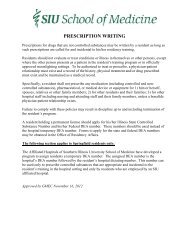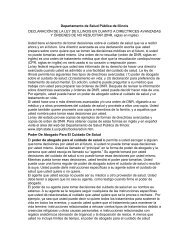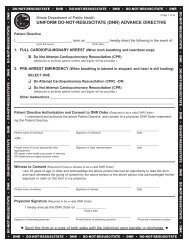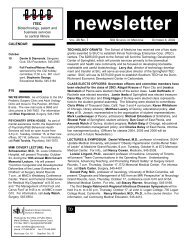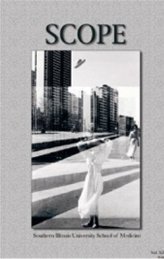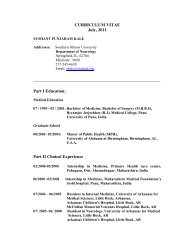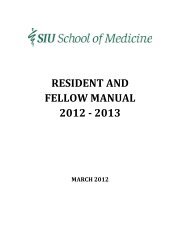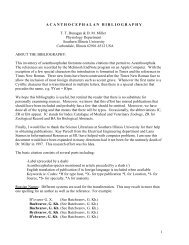Ch. 54 – Biliary System
Ch. 54 – Biliary System
Ch. 54 – Biliary System
Create successful ePaper yourself
Turn your PDF publications into a flip-book with our unique Google optimized e-Paper software.
Box <strong>54</strong>-4 Indications for Intraoperative<br />
<strong>Ch</strong>olangiogram<br />
Elevated preoperative liver enzymes (AST, ALT, ALP, bilirubin)<br />
Unclear anatomy during laparoscopic dissection<br />
Suspicion of intraoperative injury to biliary tract<br />
Dilated common bile duct on preoperative imaging<br />
Gallstone pancreatitis without endoscopic clearance of common<br />
bile duct<br />
Jaundice<br />
Large common bile duct and small stones<br />
Unsuccessful preoperative endoscopic retrograde<br />
cholangiopancreatography for choledocholithiasis<br />
gallbladder is dissected from the liver bed, starting with<br />
the fundus. Alternatively, the retrograde technique can<br />
be used where the dissection is initiated with the fundus<br />
and the artery and duct identifi ed, ligated, and divided<br />
as a fi nal step. It is important to keep the dissection as<br />
close to the gallbladder as possible, to avoid dissection<br />
into the liver and subsequent bleeding. The dissection is<br />
carried proximally toward the cystic artery and the cystic<br />
duct, which are then ligated and divided.<br />
Common Bile Duct Exploration<br />
In patients with large and multiple stones or dilated<br />
ducts, and when endoscopic therapy fails, laparoscopic<br />
common bile duct exploration is indicated. If unsuccessful,<br />
conversion to open surgery is necessary, whereas<br />
postoperative ERCP should be used as the last resource.<br />
After intraoperative cholangiogram indicates the presence<br />
of choledocholithiasis, the surgeon is faced with many<br />
options. A wide array of techniques and tools are at a<br />
surgeon’s disposal. The initial step is to determine the<br />
important factors regarding which modality of treatment<br />
will best serve the patient. Factors such as diameter and<br />
anatomy of the cystic and common bile ducts, number<br />
and size of CBD stones, clinical status of the patient, and<br />
most importantly, technical skill of the surgeon should<br />
all be considered.<br />
Laparoscopic Approach<br />
If the stones are small, use of saline irrigation through<br />
the cholangiogram catheter to fl ush the stones into the<br />
duodenum is all that is necessary. Relaxation of the<br />
sphincter of Oddi with glucagon may be helpful. If irrigation<br />
is unsuccessful, a balloon catheter may be passed<br />
through the cystic duct and down the common bile duct,<br />
where it is infl ated and withdrawn to retrieve the stones.<br />
The next attempt should be made with a wire basket<br />
passed under fl uoroscopic guidance to catch the stones.<br />
If needed, a fl exible choledochoscope is inserted directly<br />
into the cystic duct (Fig. <strong>54</strong>-17). The cystic duct may have<br />
to be dilated to allow its passage. Although most authors<br />
advocate fi rst attempting a transcystic access, there are<br />
clear indications for a direct common bile duct exploration<br />
fi rst. The most common scenarios are the presence<br />
of more than fi ve common bile duct stones, stones larger<br />
than 9 mm, and common hepatic duct stones. Once in<br />
the common bile duct, the stones may be caught into<br />
<strong>Ch</strong>apter <strong>54</strong> <strong>Biliary</strong> <strong>System</strong> 1565<br />
Box <strong>54</strong>-5 Indications for Open <strong>Ch</strong>olecystectomy<br />
Poor pulmonary or cardiac reserve<br />
Suspected or known gallbladder cancer<br />
Cirrhosis and portal hypertension<br />
Third-trimester pregnancy<br />
Combined procedure<br />
a wire basket under direct vision or pushed into the<br />
duodenum.<br />
When the duct has been cleared, the cystic duct is<br />
ligated and cut and the cholecystectomy is completed. If<br />
the cystic duct cannot be dilated, a longitudinal choledochotomy<br />
should be made on the anterior wall. After<br />
adequate dissection, anterior choledochotomy can be<br />
used. A longitudinal incision is favored because of the<br />
pattern of terminal arterioles supplying the common bile<br />
duct. Postoperative biliary drainage with a T tube may<br />
then be necessary. Clearance of all common bile duct<br />
stones is achieved in 75% to 95% of cases with laparoscopic<br />
common bile duct exploration. 19 Many studies<br />
have shown similar effi cacy of laparoscopic common bile<br />
duct exploration as endoscopic sphincterotomy and laparoscopic<br />
cholecystectomy, while demonstrating signifi -<br />
cant cost analysis in favor of common bile duct exploration<br />
at one setting.<br />
Open Approach<br />
With the increased use of endoscopic, percutaneous, and<br />
laparoscopic techniques to treat common bile duct stones,<br />
the open common bile duct exploration is rarely performed<br />
today. It is now commonly used as a last resort<br />
if the above therapies fail. The techniques and operative<br />
manipulations are similar to the laparoscopic approach.<br />
In patients with a nondilated bile duct (>4 mm), a transduodenal<br />
sphincterotomy should be performed and the<br />
duct explored through the sphincteroplasty. This avoids<br />
the need for a postoperative T tube and the potential for<br />
a late bile duct stricture. With the use of intraoperative<br />
choledochoscopy, the rate of retained common bile<br />
stones is less than 5%.<br />
Drainage Procedures<br />
If the stones cannot be cleared or when the duct is very<br />
dilated (>1.5 cm in diameter), a choledochal drainage<br />
procedure should be performed. Options for biliary<br />
drainage include a side-to-side choledochoduodenostomy<br />
or a choledochojejunostomy with a Roux-en-Y limb<br />
of jejunum. Surgeon preference dictates which approach<br />
is used. Use of the duodenum is preferred if the duodenum<br />
can be fully mobilized (Kocher maneuver) and there<br />
is minimal scarring. Any concerns about tension should<br />
prompt use of the jejunum either as an end-to-side or<br />
side-to-side confi guration.<br />
Transduodenal Sphincterotomy<br />
In the current era, endoscopic sphincterotomy has<br />
replaced open transduodenal sphincterotomy. If an open<br />
procedure for common bile duct stones is being done in<br />
which the stones are impacted, recurrent, or multiple, the



